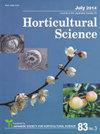Root-zone Cooling at High Air Temperatures Enhances Physiological Activities and Internal Structures of Roots in Young Tomato Plants
Journal of The Japanese Society for Horticultural Science
Pub Date : 2013-10-01
DOI:10.2503/JJSHS1.82.322
引用次数: 14
Abstract
Low-cost technology is needed to alleviate high-temperature injury for high-yield greenhouse tomato production. To acquire information about the physiological and morphological effects of root-zone cooling, we grew young tomato plants for 2 weeks in nutrient solution held at about 25°C, considered to be the optimum temperature for tomato plants. We investigated plant growth, nutrient uptake, root activity (xylem exudation and root respiration rate), root indole-3-acetic acid (IAA) concentration, and internal root structure. The root-zone temperature was maintained at 24.7°C by cooling, while the air temperature and control temperatures were higher than optimum (30.8 and 33.7°C, respectively). Root-zone cooling increased the relative growth rate (RGR) of roots compared with the control, followed by shoot RGR. Root IAA was positively correlated with root RGR. Root-zone cooling increased Ca and Mg uptake as well as root xylem exudation and respiration. It also advanced the development of the internal structure of the xylem near the root tip. Thus, possibly by increasing root activity and root IAA, root-zone cooling promoted root growth and nutrient uptake mediated by the development of the root xylem, and thus shoot growth. These results suggest a physiological and morphological mechanism of growth enhancement by root-zone cooling under high air temperature conditions.高温下根区降温对番茄幼苗根系生理活动和内部结构的影响
温室番茄高产生产需要低成本技术来减轻高温伤害。为了了解根区降温对番茄的生理和形态影响,我们在25°C左右的营养液中培养番茄幼苗2周,认为25°C是番茄植株的最佳温度。我们研究了植物的生长、营养吸收、根系活性(木质部渗出量和根系呼吸速率)、根吲哚-3-乙酸(IAA)浓度和根内部结构。降温使根区温度维持在24.7℃,而空气温度和对照温度均高于最适温度(30.8℃和33.7℃)。根区降温使根系的相对生长率高于对照,其次是茎部的相对生长率。根系IAA与根系RGR呈正相关。根区降温增加了钙和镁的吸收以及根木质部的渗出和呼吸。它还促进了根尖附近木质部内部结构的发育。因此,根区降温可能通过提高根活力和根IAA,促进根生长和由根木质部发育介导的养分吸收,从而促进茎的生长。这些结果提示了高温条件下根区降温促进植物生长的生理和形态机制。
本文章由计算机程序翻译,如有差异,请以英文原文为准。
求助全文
约1分钟内获得全文
求助全文
来源期刊
自引率
0.00%
发文量
0
审稿时长
>36 weeks

 求助内容:
求助内容: 应助结果提醒方式:
应助结果提醒方式:


